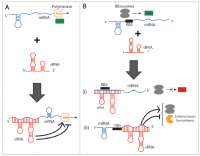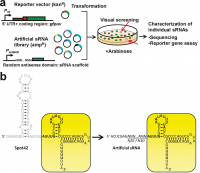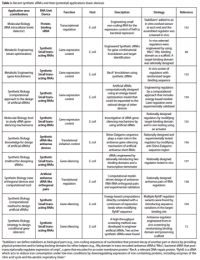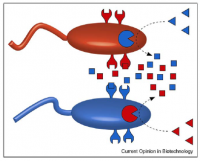CH391L/S14/SmallRNAs
Bacterial small RNAs: a powerful tool for metabolic engineering
Introduction
Bacterial small RNAs (sRNAs) are gene regulatory entities that range from 21 to 400 nucleotides in size. These RNAs are in charge of controlling expression of stress-response genes thus are essential for organism survival under different extreme environmental conditions (e.g. nutrient availability, osmolarity, pH and temperature)[1]. The presence of these regulatory molecules appears to be ubiquitous as they have been discovered in a wide range of bacterial species [2][3]. Their high modularity and orthogonally have risen interest among synthetic biologists for the construction of sRNA-like devices. In addition, sRNA capacity to simultaneously multiple genes has enabled the vision of sRNAs as a powerful tool for metabolic engineering applications. Hereby I will focus on a specific type of sRNA and its presence in synthetic biology.
Bacterial small RNAs

sRNAs can be classified in cis-encoded and trans-encoded. The former refers to those that are transcribed from the complementary strand of the genes that they target. This class represents the minority of the sRNAs that have been identified up to now. Additionally, cis-encoded sRNAs usually exert a tight control over single target messenger RNA (mRNA). In contrast, trans-encoded sRNAs are transcribed from loci in the genome that are distant from where their mRNA targets are encoded. This class accounts for the great majority of sRNAs discovered to date. An astonishing feature is that these molecules can bind their mRNA partners by a minimal base-pairing requirement (8-9 nucleotides)[1]. Lastly but more importantly, this class of sRNAs can interact with multiple mRNAs[5]. This property in turn enables the potential application of combinatorial gene knockdown in metabolic engineering.
Trans-encoded sRNAs can target proteins in addition to mRNAs, an example of that are sRNAs such as CsrB/C and 6S RNA. When controlling mRNA expression this class of sRNAs uses a diversity of mechanisms. They can (1) base-pair to their target mRNAs to enhance or attenuate transcription (Figure 1A), (2) directly block (Figure 1B i), or indirectly enhance or inhibit translation (Figure 1B ii), (3) sequester proteins (not shown), or (4) directly lead to mRNA and protein degradation (Figure 1B iii). In this article I will exclusively focus on those sRNAs that are trans-encoded and only target mRNAs. Hereafter, I will refer to them simply as sRNAs. This class of sRNAs, as aforementioned, accounts for the majority of discovered sRNAs and can target multiple genes. Consequently, these sRNAs have attracted much interest among the Synthetic Biology community as I will show in the remainder of this article.
A particular feature that this class of sRNAs exhibits is the interaction with a major chaperone protein called Hfq. These interactions have been mainly observed in gram-negative bacteria. Hfq action leads to the stability sRNAs, assists their binding to target mRNAs and stabilizes interactions sRNA-mRNA (ref 43). Recent reports propose that Hfq can also exert negative regulation by delivering the sRNA-mRNA complex to the degradosome [3]. By engineering Hfq interaction gene expression control could potentially be greatly improved by enhancing its dynamic range. In addition, the introduction of Hfq domains into an already constructed sRNA-like device could bring about a very valuable multiple-target capability.
sRNAs in Synthetic Biology

sRNAs are highly composable, (composability is the ability of a system to berak down in units due to the system modularity and recombine in different configurations to satisfy specific human requirements), tunable and their orthogonallity can be designed a priori. In general, a variety of strategies have been used to synthetize sRNAs that include rational design, model-driven computational design, in vivo and in vitro molecular evolution and selection and, harvesting natural parts [4]. Efforts have focused on preserving the sRNA scaffold, which includes a Hfq domain and transcriptional terminator, and engineering the binding domain (see Figure 2 for a schematics of sRNA breakdown).
Designing a synthetic sRNA

Three factors likely influence sRNAs ability to regulate gene expression: kinetics of binding, extension and energy of binding as well as the types and number of mRNAs that a given sRNA can bind. Based on these factors Sharma et al.[6] developed a high-throughput strategy for the engineering of synthetic sRNAs. In their approach, the Hfq domain was left unchanged and a library of randomized binding domains was generated. A natural 5’ UTR was fused to a reporter gene (GFP) and the researchers selected for the repression of this gene. They were able so successfully identify sRNA candidates that repress ompF and fliC mRNAs. Interestingly, the authors observed that the artificial constructs repressing the ompF exhibit important similarities in the features shown by the natural ompF repressor, the sRNA MicF (Figure 3). A recent work studied the free-energy of the complex sRNA-mRNA and found an important correlation between structure-function in sRNAs. Hao et al. [7] generated numerous mutants of the sRNA RyhB and tested in vivo their gene control function. They concluded that when using a thermodynamic model to compute the free-energy of the mRNA-sRNA complex, these values exponentially correlated to the gene silencing strengths showed by the mutants.
sRNAs in metabolic engineering
As aforementioned, sRNAs are ideal candidates for developing and alternative methodology for the combinatorial knockdown of genes in metabolic engineering. Towards these purposes, Na et al.[8] generated a library of artificial sRNAs that target a diversity of chromosomal gene targets. Then, by a combinatorial approach they isolated a strain that was able to substantially increase cadaverine production and tyrosine production. This approach is generalizable to other bacterial strains. The strategies proposed by the authors possess important advantages over traditional gene knockouts methodologies due to the ability to fine-tune gene silencing, target multiple genes, easy-implementation and the ability to modulate gene expression without modifying those genes. These strategies avoid the burdensome generation of strain libraries.
As it can be confirmed from table 1, there are very few examples of the use of sRNAs for metabolic engineering applications. I believe this field will soon explode to produce numerous works and even applications aiming to better strain optimization techniques even for biotechnologically relevant molecules.

Control of E. coli cell localization within a consortium via the artificial manipulation of chemotaxis

In a representative example, Goldberg et al. [10] in the same study described in section above exploited the “hitchhiker” effect observed in which cells lacking the enzymatic activity can be induced to motility by cells that produce the proper ligand. They engineered two E. coli strains to form a consortium in which each of them can produce the ligand that induces chemotaxis in the other strain. Specifically, one strain was engineered to produce the native aspartate chemoreceptor and penicillin acylase, the other strain was designed to express a PAA-responsive mutant chemoreceptor and asparaginase II. The observed behavior of the consortium was that of an “AND” Boolean gate since when each strain was isolated and put in contact with the appropriate ligands, no chemotaxis was observed. In contrast, when the two strains were plated in close proximity, the two chemical signals were present and the strains were motile (Figure 5). This research work advances the possibility of utilizing these engineered strains in a real environment since bacterial populations are usually better fit to thrive when living in consortia.
Engineering the intracellular chemotactic pathway vs the manipulation of chemoreceptor sensitivity
The advantages and disadvantages of both approaches presented above are summarized in the following table (information taken from [9] ):
| Intracellular engineering by RNA molecules | Chemoreceptor manipulation | |
|---|---|---|
| Advantages | 1. Ability to introduce RNA molecules into organisms with minimal modification
2. Capability to evolve RNA molecules (riboswitches) to recognize a completely novel ligand |
1. Intracellular machinery remains in place facilitating adaptation responses
2. Response times are dictated by the native schemes and are expected to be lower than the RNA counterpart. |
| Disadvantages | Longer response times since ligand has to diffuse inside the cell which translates into a reduced capacity of adaptation | Reduced plasticity since chemoreceptors are limited by a structural scaffold and marginal range of modification is expected. |
Potential applications: the paradoxic “therapeutic bacterium” and more
In a proof of concept of a medical application, Anderson et al. [11] engineered E. coli to invade cancer cells depending on the local environment. The researchers control E. coli behavior by introducing the gene that allows cell invasion, inv gene, under the control of native promoters that act under specific conditions of hypoxia or cell density. By this approach they were able to control when and where cell invasion take place. This example and the others described above enable the vision of almost surreal applications such as a “therapeutic E. coli” in which its chemoctactic activity is engineered to detect disease sites and then release drugs for whose production the organism had been rewired a priori. This means that the field of potential applications is unlimited in areas such as target cell therapy and regenerative medicine, drug delivery, and even other non-medical applications such as biosafety and anti-biofouling in pipes, boats, implantable devices and surgical instruments [4].
Engineering other types of motility
Synthetic Cilia-like structure engineered to help understand the functioning of biological cilia
Cilia are highly conserved eukaryotic structures essential for reproduction and survival of many biological organisms. In this work, Sanchez and collaborators [12], molecularly engineered cilia to study how the biological version functions. The authors describe a minimal model system composed by densely packed, actively bending bundles of microtubules and molecular motors, spontaneously synchronize their beating patterns. This simplified in vitro model of eukaryotic cilia could bring insights into the beating of isolated cilia and the synchronization of their beatings.
iGEM projects on chemotaxis
A couple of examples of iGEM projects associated with chemotaxis and motility engineering are as follows:
Back in 2012, team Göttingen developed a selection method to engineer a strain that they called “Homing E. coli”. Through genetic manipulation and directed mutagenesis, they were able to optimize E. Coli’s capacity to quickly travel through a chemo-attractive gradient of aspartate. They identified FlhDC as a cellular factor for flagella enhancement and elongation, and created a library of receptors that they will soon explore to modify specificity of the receptor and, ultimately, motility of the E. Coli. Specifically they applied directed evolution to chemoreceptors by targeting five amino acid residues in the ligand binding site. In order to select for the appropriate phenotype, a new special "swimming" plate was developed by using a low concentration of agar (0.3%). Several tests were run to determine incubation times and temperature, nutrients and chemoattractant concentrations, and even the right strain. They chose BL21 cells in 0.3% swimming agar at 33 C for 1-2 days. After determining the appropriate "swimming" assay, the team started investigating genes involved in the flagellar function of E. coli and their effect on bacterial motility when over-express from a plasmid. They found that gene yhjH had a relatively important positive effect in the "swimming" behavior of the cells since by over-expressing from plasmids, the ability of cells to brake was considerably diminished and biofilm formation appears to repressed. These results are in accordance to the functions that gene yhjH regulates in E. coli. fliC (flagellin) encodes for the structural protein that builds up the filament of the bacterial flagellum. By overexpressing it the authors observed a similar behavior to yhjH versions. A higher motility than the control was observed in general when overexpressing flhDC (master regulator of motility and chemotaxis), however inconsistent results prevent the authors from obtaining definitive conclusions. In general, by overexpressing genes such as yhjH (releases brake and spreads individual cells), fliC (makes stronger and elongated flagella) and flhDC (increases number of flagella), a relatively positive effect on E. coli motility was observed [13].
In 2010, team UPO-Sevilla explored their capacity to concentrate populations of bacteria, or enhance a phenomena termed “Bacterial Crowding”. This fundamentally requires a strain (containing the Prh system) to sense a non-diffusive chemical attractant and subsequently release signals to attract other bacteria to crowd there. This team used two chemo-attractants: aspartate and salicylate, in the hope of demonstrating that they can induce crowding of a strain that is not chemo-sensitive to salicylate.
References
Error fetching PMID 20980440:
Error fetching PMID 21925377:
Error fetching PMID 23362267:
Error fetching PMID 21742981:
Error fetching PMID 23334451:
Error fetching PMID 24356572:
Error fetching PMID 21778400:
Error fetching PMID 4598187:
- Error fetching PMID 15487940:
Comprehensive review on bacterial small RNAs - Error fetching PMID 20980440:
A more recent review on bacterial small RNAs. - Error fetching PMID 21925377:
Another recent review on bacterial small RNAs. - Error fetching PMID 24356572:
A thorough review on synthetic regulatory RNAs. - Error fetching PMID 23362267:
A review on sRNA negative regulation. - Error fetching PMID 21742981:
sRNA structure-function relationship. - Error fetching PMID 23334451:
sRNAs in metabolic engineering. - Error fetching PMID 21778400:
Engineered cilia for studying biological motility. - [1] http://2012.igem.org/Team:Goettingen/Project
A iGEM chemotaxis project for the engineering of "Homing Coli". - 2012 pmid=23651005
High-throughput method for the engineering of sRNAs. - Error fetching PMID 4598187:
Paper describing thoroughly the chemotaxis phenomenon.